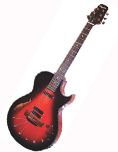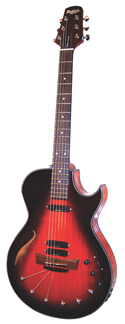Babicz Octane Hollowbody Electric Guitar


TRADITIONAL GUITAR DESIGN is full of compromises. Intonation, action, tone and playability are affected by the need to create an instrument that can perform reasonably well in a variety of circumstances. That's why acoustic guitars suffer from dead spots, solidbody electric guitars don't resonate and magnetic pickups have a limited range.
Jeff Babicz is one of a handful of guitar builders willing to rethink the guitar's design. The Octane, his company's first electric guitar, uses innovative ideas like lateral compression, a continuously adjustable neck and slick electronics to expand the guitar's capabilities without robbing the instrument of its character. The Octane is available in both magnetic-only and magnetic/piezo hybrid pickup configurations. I tested the latter.
FEATURES
The most striking feature of any Babicz guitar is the way the strings fan from the specially designed bridge and terminate at points spread out across the lower bout. That's not for show; it's an important element in Babicz's Lateral Compression soundboard, where the strings exert tension on the top to improve resonance, playability and tone. Babicz likens the effect to that of a drumhead under tension.
Perhaps it's why the Octane offers remarkable tonal balance up and down the frequency range and across all six strings. Notes ring and sustain solidly. On standard guitars (acoustic guitars in particular), some of the lower notes tend to smear together on chords. On the Octane, each note speaks clearly, and with minimal effort from the player.
The Octane evolved from Babicz's acoustic designs and is more acoustic in look and feel than the typical electric-based hybrid. The single-cutaway hollowbody features solid mahogany back and sides topped by a nicely figured piece of solid mahogany. The continuously adjustable mahogany bolt-on neck lets you raise or lower the action to accommodate your needs (for example, high for slide, low for fingering). The neck, capped by a 25 1/2- inch-scale rosewood board, is fat and comfortable (think vintage Gibson). Considering the guitar's potential as a rock/blues screamer, I was surprised to find only 20 frets.
PERFORMANCE
The Octane generates a reasonably loud unplugged tone, but this is no acoustic guitar. The magnetic pickups are standard; the piezo/preamp system is a $400 option. My guess, however, is that most players will opt to go for the acoustic-electric setup, which consists of an L.R. Baggs Element under-saddle pickup and a custom Baggs preamp that blends the signals from the magnetics and the piezo. The preamp includes EQ controls (accessible behind the control plate at the back of the guitar) that can be fine tuned. The top-mounted blend control is continuously variable between fully magnetic and fully piezo. On the test guitar, magnetic and piezo used the same output, but Babicz reports that systems with dual outs can be custom ordered.
The Octane is incredibly satisfying as a straight-ahead electric guitar. Babicz offers a choice of Seymour Duncan magnetic pickup configurations. The guitar I tested (officially known as the OT- 818TB-06-3Se Tobacco Burst) sported three single-coil-sized humbuckers-a Cool Rails in the neck position, and Hot Rails in the middle and bridge slots-mated to a five-way switch, master volume and master tone controls. Tested with a Mesa Nomad combo, the pickups sounded funky, bluesy and sweet. The guitar's inherent acoustical qualities really translated, offering breathtaking sustain and clarity.
All the latest guitar news, interviews, lessons, reviews, deals and more, direct to your inbox!
I wasn't expecting much from the piezo through the Nomad, but it sounded good in combination with the magnetic, not as an acoustic guitar substitute, but as a way of adding even more detail on chord parts. I've never heard an amplified open G chord with as such sparkling shimmer.
With the Nomad set to scream, the Octane rocked, with and without the piezo in the mix. Fat, detailed, crunchy, nasty-all shades were available with a flip of a switch or a dial of the guitar's volume control. Even at high volume, this hollow guitar remained under remarkable control with the magnetic pickups active, though with the piezo high in the mix, the guitar did erupt into to resonant feedback. (Babicz reports that you can tweak the internal EQ to dial it out.)
Plugged in direct into a full-range studio system, I was able to produce very convincing acoustic guitar type sounds, especially when blending the neck magnetic with the piezo. Were I were using the guitar for jazz and solo performance, I might opt for one of the humbucker configurations.
THE BOTTOM LINE
The Babicz is a remarkable instrument. It's one of the most responsive and expressive guitars I've ever played, and one of the most sonically versatile. Space doesn't permit a full examination of the instrument's technology and design, but it's worth a trip to the website for a read-and a trip to a dealer to test one in person.
